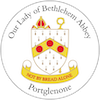In keeping the memory of St Pachomius we travel back to the very roots of our monastic life to the one who is recognised as the founder of community monastic life. The tradition of the solitary desert life was already well enough established before Pachomius, with St Antony of Egypt the outstanding example and teacher. Pachomius looks to place a different emphasis, and sees a supreme necessity if people are to find a true Gospel path and vocation in the monastic way – life lived in common.
Pachomius was born a pagan in Upper Egypt toward the end of the third century. As a young man he was drafted into the army to fight in the civil war then raging and on the way to the front he and his comrades were locked in a prison for the night. The people of the locality brought food and water to the conscripts, and when he asked who they were and why they did this, Pachomius was told that they were Christians. He resolved, when he had his freedom, to devote his life to the service of humanity. On release from the army he was baptised and sought out a hermit to instruct him in the solitary life. But after some wandering, prayer and encounters with God’s voice he settled in an abandoned village called Tabennesi, where he soon began to attract others to a common way of life.
Monastic life at Tabennesi may have begun around 320, and it soon became, under Pachomius, a very elaborate and detailed affair. There is some suggestion that the high degree of organisation which we see in the Pachomian monastic settlement comes from his own experience of military discipline and good order – the monks were stationed in various regimented dwellings, and the monastic settlement had all the buildings and provisions needed for independent life, without having to go frequently beyond the surrounding wall. The monks each had specific tasks in service of the community. The numbers grew so large that Pachomius made a second settlement, at Pbow, to which he eventually moved himself. When he died of the plague in 346 there were eleven monasteries associated with his community, two of which were for women. As often happens following the death of a charismatic founder such as Pachomius his monasteries suffered factional division and struggle, and, although they persisted for another century, eventually gave way to other monastic paths, of which many were beginning to emerge.
Above all in Pachomius – and it was the term which he himself used to describe his monastic foundations and way of life – we are given a word which has become almost synonymous with monastic life lived in common – the Koinonia. The term is first seen in the Acts of the Apostles, 2:42 and 4:32, describing the early Christian community:
“These remained faithful to the teaching of the apostles, to the brotherhood, to the breaking of bread and to the prayers. And all who shared the faith owned everything in common…. The whole group of believers was united, heart and soul; no one claimed private ownership of any possessions, as everything they owned was held in common”.
The term koinonia describes this common life – really, it is the shared way or common way of doing things and living, the way of going about a life which is common to all and makes sense to all. So, koinonia means fellowship, or community, or shared existence. And yet in the Christian sense it goes beyond that physical reality of living together and sharing material, and spiritual, goods so that everyone’s needs are met and no one is found wanting. Koinonia indicates a deeper level of shared existence, and so might even be taken as communio – communion of life.
For the Cistercian Fathers, reflecting most probably on the life of Pachomius – of which there were a number in the ancient world – and on the teaching in the Rule of St Benedict – the common life, the Cistercian koinonia, is always called to be a reflection of the perfect community life of the Three Divine Persons in the Unity of the Trinity. This is the mystery to which our communio reaches out, acknowledging it as both source and goal. So, we can say with Baldwin of Forde in his own exquisite definition of community life – that it is amor communionis et communio amoris – the love of sharing and the sharing of love.
Today we ask St Pachomius’s prayers and intercession for our own Community at Bethlehem Abbey, for the wider eCommunity of those who join us through these meditations in sharing some aspect of our life, and for all the various communities to which we belong.
-Part of our ‘Celebration of the Saints’ series-
Other posts…

